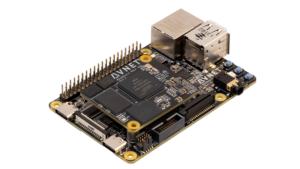The new MaaXBoard 8ULP starter kit from Avnet features the i.MX 8ULP processor from NXP Semiconductor and will help facilitate the development of ultra-low-power, secure, intelligent edge applications.
 Implemented as a compact System-on-Module (SOM) with carrier board (in popular single-board computer format), this platform includes a multifunction development interface, plus well-supported communication and expansion interfaces, to maximize its overall utility for developers of new custom products.
Implemented as a compact System-on-Module (SOM) with carrier board (in popular single-board computer format), this platform includes a multifunction development interface, plus well-supported communication and expansion interfaces, to maximize its overall utility for developers of new custom products.
This board will be exhibited in the Avnet Silica booth at Embedded World (June 21–23 in Nuremberg, Germany), alongside a range of new development boards engineered by Avnet, focused on edge-AI applications.
“Use of the NXP i.MX 8ULP applications processor and PCA9460 PMIC on the Avnet SOM provides a promising new option for developers implementing energy-efficient, secure edge-AI applications with advanced audio and display capabilities,” said Amanda McGregor, senior director of Product Innovation, Advance Edge Processors, NXP.
Efficient control of energy usage is facilitated by architectural features of the i.MX 8ULP device, which includes the partitioning of processing resources into application domain (1.2GHz Dual-Core Arm Cortex-A55 cores), real-time domain (216MHz Arm Cortex-M33 core and Fusion DSP), and Low-Power Audio Video domain (600 MHz HiFi 4 DSP).
The MaaXBoard 8ULP’s small, 43 x 36mm form-factor SOM includes the NXP i.MX 8ULP applications processor and power-management IC (PMIC) plus abundant memory resources, including:
- On-chip shared RAM (768 KB)
- Power-efficient 32bit wide LPDDR4X DRAM (2GB)
- Octal PSRAM (8 MB)
- eMMC 5.1 flash (32 GB)
- Octal SPI NOR flash (4 MB) non-volatile memory
The memory architecture enables ultra-low power capabilities by supporting independent, real-time, and application processing domains. Two 100-pin connectors interface the SOM to the carrier board.
“Utilizing the small form factor of the MaaXBoard 8ULP ensures the most complex aspects of the hardware implementation are already pre-engineered in the SOM — significantly reducing the engineering risk and providing a path from development to integration into custom products,” said Jim Beneke, VP of Products & Emerging Technologies, Avnet. “It also reduces supply chain risks since the compact SOM replaces dozens of components, many of which have long lead times.”
The MaaXBoard 8ULP carrier baseboard (based on the compact Raspberry Pi form-factor) supports a versatile set of I/O interfaces. These include:
- Gigabit Ethernet
- Two USB 2.0 host interfaces plus USB 2.0 device interface
- MIPI DSI display and MIPI CSI camera interfaces
- Expansion headers supporting the 40-pin Pi-HAT compatible header, MikroE Click 16-pin header, and ADC/DAC 6-pin header
- Audio applications are supported via onboard audio codec, digital microphone, and stereo headphone jack I/O
- Power is sourced via USB-C connector and is managed via the PCA9460B PMIC on the SOM, plus three additional voltage regulators
A unique aspect of this board is its debug subsystem, which supports remote USB access to three UARTs, 16bit I/O expander-based remote control and monitoring, and an optional integrated SWD/JTAG or 10-pin-header debugger interface. The built-in remote control, monitoring, and integrated debugger are modeled on the capabilities on NXP’s i.MX 8ULP EVK platform, allowing developers to use NXP’s BCU software utility to remotely set boot mode, reset the board, reflash the memory, and monitor the processor mode.
Expansion via a well-established ecosystem of HAT boards and Click boards (more than 1,200 different MikroE Click boards are available) enables developers to tap into a broad range of prototyping options. An M.2 module connector on the backside of the carrier board facilitates the easy addition of 801.11ac Wi-Fi and Bluetooth 5.1 connectivity using an optional certified M.2 wireless module. Other available accessories are a 7-inch MIPI-DSI LCD panel, a 5 MP MIPI-CSI camera, and 5V/3A (USB-C connector) power supply.




